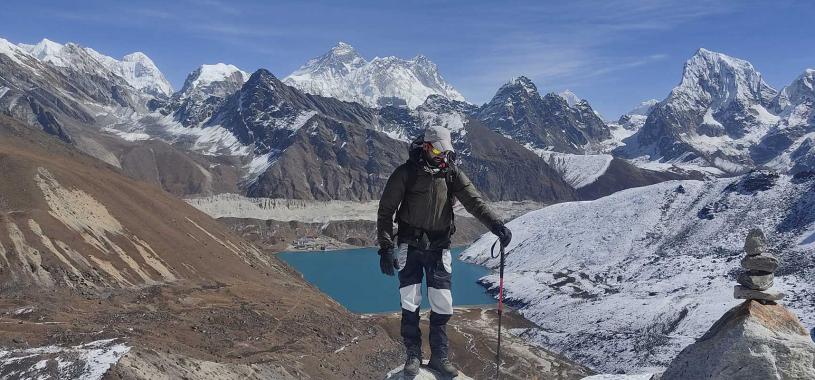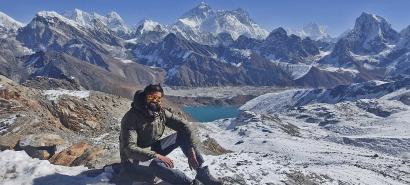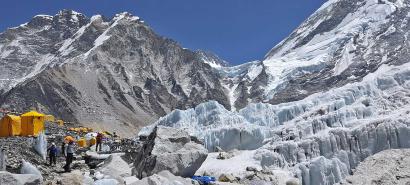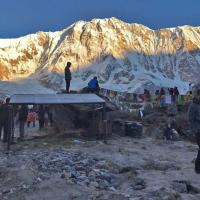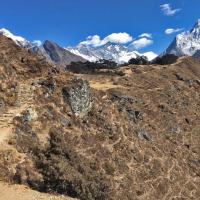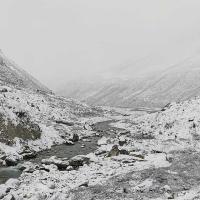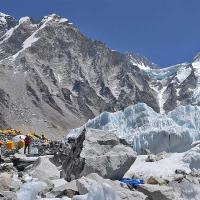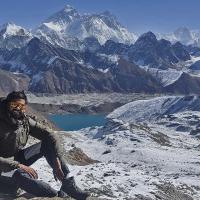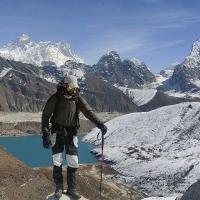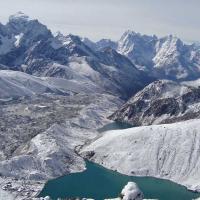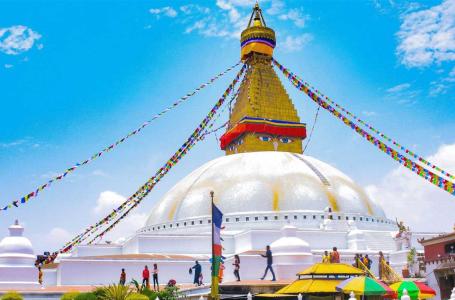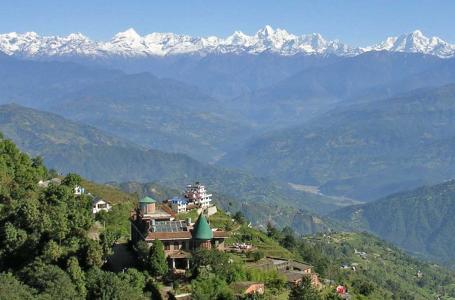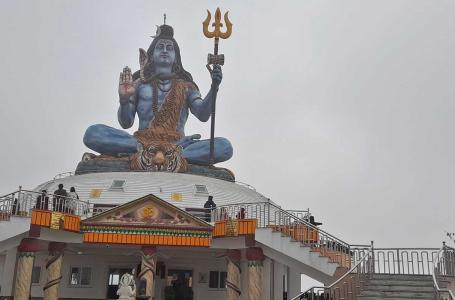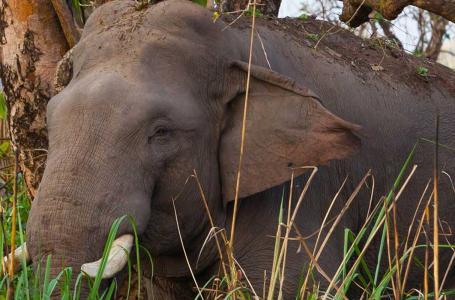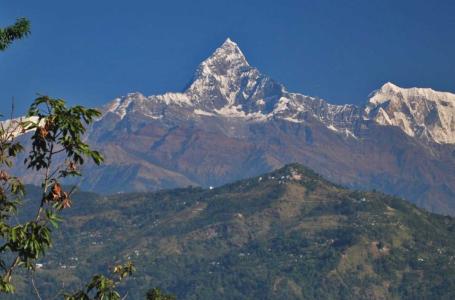- 01 Pax USD 1925 pp
- 02 to 05 Pax USD 1825 pp
- 06 to 10 Pax USD 1725 pp
- 11 to 15 Pax USD 1575 pp
Itinerary
In the peak season, there is a flight available from Ramechhap to Lukla. The journey from Kathmandu to Ramechhap takes approximately 5 hours by road, where you will need to catch a bus from Thamel around 1.30 am. You will reach at Ramechhap airport around 6.30 am and then proceed to wait for your flight to Lukla. However, during off-peak times, you have the option to fly directly from Kathmandu airport to Lukla.
The short flight to Lukla takes about 25-45 minutes. Yet, it is incredibly fascinating with first-class views of the mountains and other undulating ridges. Upon landing at Lukla airport, in one of the shortest runways in the world, we will proceed towards our next station, Phakding. The trail to Phakding passes through the farm fields and quaint settlements of Chopulu. A few distances ahead, a gorgeous view of the Kusum Kanguru peak welcomes you to another village of Ghat. The main village of Phakding is not very far away from there.
From Phakding, the path to Namche starts by crossing a suspension bridge to be on the west side of the river. While there are Chortens and Mani walls keeping track of your footsteps, you will be amazed typically by the traditional mountain houses of Sherpa people. A beautiful waterfall at the village of Toctoc is a wonderful inspiration to proceed ahead to the Sagarmatha National Park.
But, eventually, another waterfall welcomes you at Bengkar, in the middle of Toctoc and Sagarmatha NP. You will check your permits in the Sagarmatha National Park and then, head through the dense jungle sheltering beautiful Blue Sheep and Snow leopards. As you cross the jungle, a beautiful Kani Gate welcomes you to the Namche, the vibrant city of the Everest.
Namche is geographically and culturally an ideal spot for acclimatization. Because of receiving most of the sunlight during the day, Namche is warm and welcoming. Even the hills, surrounding the Namche, have welcomed the visitors by being a perfect viewpoint to see the heavenly peaks of Everest, Ama Dablam, and Lhotse. The museums and monasteries display the rich culture and time-honored history of mountain people. Namche is, indeed, a flabbergasting town.
From Namche, many side trips can be attempted. But, the most rewarding option is to hike to Khumjung and Khunde. The Hillary Hospital, founded by Sir Edmund Hillary and the traditional Khumjung monastery are the highlights of this hike, but there is much more to see and learn from this incredible short hike. It is also an acclimatization hike, so don’t mess up the adventure by going fast.
From Namche, the rightmost trail takes us to Tengboche via the fabulous Tenzing Norgay Memorial Stupa. A few distances ahead from this monastery, we will come across a beautiful viewpoint overlooking the peaks of Ama Dablam, Lhotse Shar, Kangtega, Taboche, and Thamserku. It is a good startup for the rest of the journey.
Within a while, a chain of 7 remarkable water-driven prayer wheels meets our eyes, before crossing a suspension bridge to Phunke Tenga. These are the rare glimpses in the mountains. As you cross the bridge, the vast pasture opens up that finally leads you to the village of Tengboche.
Pay a visit to the Tengboche Monastery, the largest monastery of the Khumbu (Everest) region. The intricate décor within and outside the monastery is worth exploring.
A trek to Dingboche is many times considered as the best day of the overall trekking in the Everest Region. The trails are exposed and offer open views of the incredible Himalayas up to the Dingboche. For a while, the views are closed up.
But, as soon as you cross a suspension bridge at Melingo, the incredible peaks of the Ama Dablam, Lhotse, Lhotse Shar, and Taboche open up wide and live. You will go parallel to the Imja Khola and encounter several little Buddhist shrines and Chortens to rinse your city soul with the purity of nature. Upon arriving at Dingboche, you will see a completely different world.
At a glance, Dingboche is nothing more than a stone village. All the houses, including the outer fencing walls, are made up of stones. Even the Chortens and monasteries are of no exception. Nevertheless, all of these beauties are fascinating.
During the day, we will hike to the Nangkar Tshang hill to watch the polished peaks of Makalu and its counterparts in the sky. The trail passes through a brief forest that introduces some of the rare species of butterflies and birds on the way. It is an exotic experience. Later, you will return to Dingboche for the night stay.
The trail to Chhukung is very much physically demanding. First, it rises to an arid meadow and then, climbs over several cliffs to finally arrive at the Chhukung. From there, the hike to Chhukung Ri begins. You will follow the snowy track for most of the journey until arriving at the top of the Ridge.
The most difficult part of this journey is the altitude. Stepping a short step feels like running in a marathon. Despite all these painful encounters, the views from the top are very much gratifying. It compensates for the pain and rewards you with additional views of the mountains and glaciers.
From Chhukung, the trail to Kongma La rises steeper and steeper until it reaches the top of the pass. While the views of the mountains on the way are not so disappointing, they are still nothing in comparison to what is seen from the Kongma La pass, the highest pass of the Everest Region.
The beautiful peaks of Everest, Nuptse, and Lhotse are incomparable to any other views. Plus, the blue glacier walls seem to inspire the neighboring buttresses to stand strong and proud on their feet. The whole mountain family appears extraordinary from the Kongma La pass. Soon, we will descend to the Lobuche for the night stay. But, the trail is very slippery.
Early in the darkness of the morning, we will leave Lobuche and walk over the moraine towards the Gorakshep. It is because the cool wind from the glaciers increases its pace in the morning hours, thereby resisting your speed.
When you are halfway ahead of Lobuche, a beautiful snowy pyramid glitters on the west. Once you arrive at Gorakshep, head towards the epic hill station of Kala Patthar, overlooking the unforgiving panorama of the whole mountain series. It is simply magical. Descend back to Gorakshep for the overnight stay.
Early in the morning, hike up to the Everest Base Camp along the snowy path. At a glance, the Everest base camp is just a vast snowscape with tents distributed in a certain flat section. You will see the summiteers preparing for their final ascent to the top of the Everest. Mostly, the views from the base camp are covered by the haze, but if you get lucky, then you will witness the rare views of the Himalayas.
Descend back to Gorakshep for lunch and then, head towards the Dzongla via the Lobuche. A beautiful turquoise Tshola lake makes your day more enjoyable until Dzongla
From Dzongla, we will leave early and then, proceed slowly towards the Cho La pass as it aids in acclimatization. The trail to the Cho La pass is narrow, icy and exposed, so there is a greater risk of falling.
Therefore, one needs to be very much careful while climbing to the top of the pass. From the pass, the view of the Ama Dablam is the best of all, while Everest, Lhotse, and Nuptse appear satisfactory. Besides, you may as well inspect the faraway view of the Gokyo valley but the lakes will be covered by the hills.
Like the ascent, the descent to the Dragnag is equally threatening. But, once you cross these trails, you are welcomed by the village of Dragnag.
The trail descends for a while from Dragnag, and then climbs steeply across the Ngozumpa glacier, the longest glacier of Nepal. Here, you will catch the fleeting glimpses of the mountains. As you descend to the Gokyo valley, leave the settlement area to see the Gokyo Lakes system, the highest freshwater lake system in the world.
Every lake in this lake system is turquoise in color because of the tiny glacial matters deposited at the bottom of the lake. Among others, Dudh Pokhari is the most beautiful and revered lake in the Gokyo lakes system. We will return to Gokyo valley later on.
From Gokyo, hike to the hill station of Gokyo Ri to witness some of the exceptional scenarios of mountains. Gokyo Ri is compared to the spectacular Kalapatthar in terms of beauty, and at times, visitors find the views from Gokyo Ri superior to that from Kalapatthar. Still, both are the gems of Everest. The peaks of Everest and other countless ranges make this vantage point a must-visit destination in the world.
Later, we will return to Gokyo valley for the overnight stay.
From Gokyo, descend to the Dole along the classic Gokyo routes. The trail follows the rocky boulders and steeply descends to Machhermo. From there, the farm fields join you on both sides of the trail before arriving at the Dole. While Dole has its own cultural magnetism, the views of the Thamserku and Taboche are truly reminiscing from there. The quaint settlements on the way are worth exploring if you like to gain some real-life experiences. Dole is perfect for learning about the Sherpas.
From Dole, we will descend back to Namche through the shortest way possible
Retrace your steps back to Lukla via Phakding. The descriptions are already mentioned above.
Catch the earliest possible flight to Kathmandu and explore the remaining places of Kathmandu on the very same day. It is so much fun to do that.
Overview
Out of the three passes, the two incredible high Passes- Cho La Pass (5,420 m) & Kongma La Pass (5,535 m) - are the exceptional viewpoints of Everest. They are popular for their spectacular glacier views, particularly of the Nuptse-Lhotse glacier wall, and the mountain glimpses of several distinguished peaks- Ama Dablam, Lhotse, Cho Oyu, Everest, Nuptse, and Lhotse. Besides watching these icy buttresses, one can see attractive glimpses of sublime Sherpa settlements-Dingboche, Gorakshep, Lobuche, and Gokyo- in the lower valley, sustaining their cultural anthem for ages under the shadow of the invincible mountains of Everest Region.
This Everest two-pass trek will push you deep into the least visited traditional villages and farm fields, where the time-honored mountains of Everest inspire the lifestyle of the local Sherpas. Their quaint stone houses, surrounded by stone walls, protect their family from the heavy winds of Everest. Their clothing, basically made from the furs of yak, is to provide warmth from the icy cold of the snowy mountains. Likewise, their tradition of sipping locally made liquor, of rice, in the rituals and ceremonies is to warm the inner vital organs. All these pieces of evidence infer that the mountains are their greatest home and they are the legends of the mighty Everest. This Everest two-pass trek package is one of the best ways to explore the Sherpas and their cultures.
This trek can be attempted in any season, but the autumn season (September, October, and November) provides the best experience that you want to gain from Everest. To do this trek, we can help you in choosing the appropriate trekking gear and other trekking essentials for a sound and productive trip. No matter whether your purpose of the visit is educational or for fun, we can set your itinerary and programs as per your purpose of visit. Let us know your expectations, and we will give you the trek of your choice.
Planning EBC with Gokyo, Cho La, and Kongma La Pass
The Everest Base Camp Trek through Gokyo Cho La and Kongma La Pass Trek necessitates thorough planning for an exceptional journey in Nepal's Everest area. To prepare for high-altitude hiking, first examine your physical fitness and speak with a healthcare practitioner. To prepare your body for the difficult terrain, follow a complete fitness plan that includes aerobic activities and strength training. Be aware of altitude, take precautions, budget properly, respect local culture, and make all required travel preparations. When properly prepared, this difficult trip provides great vistas and cultural experiences.
The best time to do the Everest Base Camp via Gokyo Cho La & Kongma La Pass Trek?
The Everest Base Camp via Gokyo Cho La and Kongma La Pass Trek is best done during the pre-monsoon (spring) season (March to May) and the post-monsoon (fall) season (September to November). This trip takes place in the spring, against a backdrop of blossoming rhododendrons and a mild environment, with bright sky blessing hikers with spectacular mountain panoramas. The nights stay rather warm, allowing for restful sleep.
Autumn, on the other hand, has a consistent weather pattern with clear skies, little precipitation, and pleasant temperatures. The sceneries are vibrantly colored, providing spectacular vistas of the Himalayan peaks. Whether you prefer the vibrant colors of spring or the crystal-clear vistas of fall, both seasons provide an unforgettable trekking experience through one of the world's most appealing locations. Trekkers should, however, be prepared for changing weather and freezing temperatures at higher elevations during their expedition.
Due to bad weather conditions and safety concerns, trekking to Everest Base Camp via Gokyo Cho La and Kongma La Pass is not suggested during two specified times of the year. First, the monsoon season, which lasts from June through August, brings considerable rain to the Everest region. This causes muddy and treacherous paths, landslides, and frequent cloud cover, which obscures the stunning mountain vistas. Second, the winter season, which lasts from December to February, brings with it bitter cold, considerable snowfall, and terrible weather. Snow and ice have covered hiking pathways, needing specialist equipment and creating avalanche concerns near high passes.
Foods and Accommodations during our trek
Almost all of the accommodations for the Everest Base Camp Trek through Gokyo Cho La and Kongma La Pass are in teahouses. These provide simple yet comfortable housing with twin-sharing rooms and communal restrooms. The food is broad, with both local and foreign alternatives, however, fresh vegetables should be avoided. Trekkers should have refreshments and water-purifying devices with them.
As you climb, your lodgings may become more basic, and your heating alternatives may become more restricted. Electronic device charging is provided but may incur an additional fee. Respect local customs and keep your environmental effects to a minimum for a mutually rewarding encounter.
It is also advised that you consult about the food to your guide for much better and hygienic selections.
Transportation
Travelers must take a four-hour shared Hiace Van trip from Kathmandu to Manthali Airport because there is no direct route from Kathmandu to Lukla. This is a result of high airport traffic in Kathmandu (October through November and March through April).
From Ramechap Manthali Airport, we will then fly directly to Lukla Airport. There is an extra charge of USD 100 when using a private vehicle. Travelers should prepare to check out at around 1 a.m. in order to catch a flight the same day.
You will be required to pay an additional sum for the hotel, which will be around USD 20 per person if you decide to stay an extra night in Ramechap in order to catch the same-day flight.
We will start our journey after we arrive in Lukla and go to Phakding from there.
Once you return to Lukla for your domestic trip to Ramechap, our tour will come to a close. From there, you must board another flight to return to Kathmandu.
Necessary permits & TIMS for EBC via Gokyo, Cho La, and Kongma La Pass
In order to visit the territory, Everest requires three sorts of permits. A Trekker's Information Management System (TIMS) Card is no longer required. These permissions can only be obtained from licensed agencies, and no freelancing guide can give them.
1. Khumbu Pasang Lhamu Rural Municipality Entrance Permit:
This permit is intended to supervise and handle tourism activity in the Khumbu region. It is necessary across the Khumbu region, including Namche Bazaar, Tengboche, Dingboche, and Gorakshep, and is valid till Jiri.
Cost: NPR 3000 Per Person for each foreigner.
2. Sagarmatha National Park Entry Permit:
The purpose of this permit is to restrict and manage entry to the Sagarmatha National Park in order to preserve its natural beauty and biodiversity. The cash collected by these permits is utilized to conserve and maintain the park.
Cost: NPR 3000 Per Person for each Foreigner
(All the permits required are included in this package).
Necessary documents for Permits:
You will only need your valid passport photocopy(validity of 6 months).
Highlights
- Breathtaking views of Mt. Everest, Ama Dablam, Lhotse, and many more peaks from Kala Patthar.
- View the world's best mountaineers throughout the expedition.
- Explore the Sherpa ethnic group's culture, hospitality, and daily life.
- Stunning vista of Gokyo Lakes.
- Nepal’s biggest Khumbu and longest Ngozumpa glaciers
- Three great high passes (Kongma-La, Cho-La & Renjo-La pass)
- Hillary Museum
- Sagarmatha National Park
- Traditional Sherpa villages, culture, traditions & hospitality
Cost Details
- Airport pickup and drop service.
- Hotel in Kathmandu 2nights.
- Flight tickets kathmandu to Lukla to Kathmandu.
- All food and accommodation during the trek.
- Transportation costs: Comfortable Drive from Hotel to Airport to Hotel.
- Experienced Government license holder English-speaking trekking guide.
- Trekking permits: Sagarmatha National Park Area fees.
- First aid medical box.
- T-shirt, Duffel Bag, and Trekking Map.
- Rescue Management Service.
- All Tax 13% VAT+10% Service charge).
- Farewell Dinner
- All kinds of Drinks.
- Visa fee to enter Nepal.
- International flight tickets and extra baggage charges.
- Extra night accommodation and meal costs in Kathmandu due to any change in the scheduled itinerary.
- All required trekking gear like sleeping bags and down jackets made available for rent.
- Travel insurance/ Rescue operation costs.
- All personal expenses (laundry, electronic device. charging cost)
- Tip for guide and porters.
- Hot and cold Shower.
Equipment List
- Woolen shirts and thick sweaters.
- Jackets (Fiber or down).
- Waterproof jacket with hood or poncho.
- Tracksuit, Track shoes and Trousers.
- Thermal Underwear and Thermal Coat.
- 2 pairs of loose-fitting long shorts/ skirts.
- Pair of Gloves and sandals.
- Woolen hat and long-sleeved shirt.
- Lightweight walking boots.
- 2 pairs of thin socks and 2 pairs of woolen socks & neck gaiter.
- Snow glasses and sunglasses.
- Trekking Sticks and Duffle bag or kit bag to carry to gear while trekking.
- Some (small/large) plastic bags to separate clean clothes from dirty ones and some smaller plastic bags to dispose of garbage.
- Daypack bag to carry your personal requirements.
- Water Bottle, water purifying tablets.
Towels, Umbrella (optional). - Headlamp, Binoculars, Camera, trekking map and compass, reading materials, pencil, rubber, pen, notebook & moisturizer for lips, face body.
FAQs
This trek follows a less crowded route to Everest Base Camp, passing through the stunning Gokyo Lakes, Cho La Pass (5,420m), and Kongma La Pass (5,535m), offering breathtaking views of Everest, Lhotse, and Ama Dablam.
These passes involve steep ascents, rocky terrain, and glacier crossings, requiring careful navigation. Hiring an experienced guide is recommended for safety and route finding.
The trek takes you through lush forests, alpine meadows, glaciers, and rugged high-altitude terrain. You may spot Himalayan thars, musk deer, danphe (Nepal’s national bird), and even snow leopards in remote areas.
Essential gear includes warm layers, a good sleeping bag (-20°C rating), trekking poles, microspikes for icy sections, sunglasses, and high-SPF sunscreen. Packing light but smart is key!
Yes! Many trekkers extend their journey by adding the Renjo La Pass to make a full Three Passes Trek or visiting Ama Dablam Base Camp for extra adventure.
Travellers Review
Trekk with Hapiness ... and Trek Mania
We did the Gokyo Lake and EBC Trekk in May 2025 with Moti (Guide) and Lakbar (Porter). The Experience was amazing. We were mainly alone on the Trekk and the weather was awesome (with one snowy exception ;)). The views on Everest, Lhotse, Nuptse and many more were astonishing and the challenging Chola Pass great fun!
Moti took good care of us and chose nice teahouses with tasty food. Lakbar is a machine and was mostly outrunning us ;).
We would definitely recommend choosing Trekk Mania and Moti as your host!
Unforgettable trip to EBC
We had an amazing time trekking to Everest Base Camp and the Gokyo Lakes with our guide, Moti. From the very beginning, we felt completely safe and well taken care of. Moti was not only professional and highly experienced, but also incredibly kind and fun to be around. He handled every detail of the trip perfectly and was always there to support us with anything we needed. We truly enjoyed his company and shared many great moments together. Thank you, Moti, for making this journey unforgettable!


